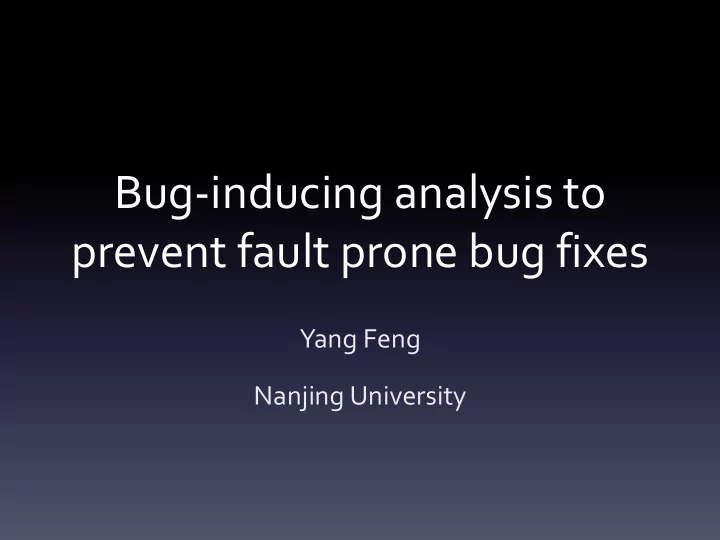

Bug-inducing analysis to prevent fault prone bug fixes Yang Feng Nanjing University
Introduction • Empirical Study • Focus on analyzing what is the most dangerous behavior in modifying code • Focus on the Object-Oriented Programming • Improve the SZZ tool
Bug-inducing analysis Step1:identify bug-fix changes(basis) examine change log messages in two ways: searching for keywords such as "Fixed" or " Bug” and searching for references to bug reports like “#42233”
an explicitly recorded linkage between a bug tracking system and a specific SCM commit
Issue list
Bug-inducing analysis Step2:trace backward to get bug-inducing changes 1.SZZ algorithm 2.Improvement of SZZ algorithm(we use)
SZZ algorithm 1. SZZ first finds bug-fix changes by locating bug identifiers or relevant keywords in change log text (finished in Step1)
SZZ algorithm 2. Run a diff tool to determine what changed in the bug-fixes
SZZ algorithm Easy in code.google(in experiment we use DiffJ) Diff details
SZZ algorithm Each different region is called a hunk hunk
SZZ algorithm SZZ assumes that deleted or modified source code in each hunk is the location of a bug
SZZ algorithm 3. Tracks down the origins of deleted or modified source code using built-in annotate feature of SCM systems(the annotate info only contains triples of current reversion line#, most recent modification revision, developer who made modification)
SZZ algorithm hit filename link To get annotate info
SZZ algorithm Hit all-versions link
SZZ algorithm It shows that the most recent modification is r1357, which SZZ considers it as bug-inducing change
SZZ algorithm We run a tool to find the differences between the bug-inducing commit(r1356- >r1357) in the same method. And the tool DiffJ will give us the change types.
SZZ algorithm For all modified files in bug-fix revision, do the same process above, get all the bug- inducing position. And include the change as a certain kind of change.
SZZ algorithm However , SZZ is imprecise 1.view formatting change as bug-inducing change… 2.Not all the hunks are bug-fixes(blank lines, comments, formatting)
Improvement of SZZ algorithm 1. Use annotation graphs to provide more detailed annotation information 2. Ignore comment and blank line changes 3. Ignore format changes 4. Ignore outlier bug-fix revisions in which too many files were changed 5. Manually verify all hunks in the bug-fix changes
Improvement of SZZ algorithm 1. Use annotation graphs to provide more detailed annotation information( the recursive version of annotation feature )
Improvement of SZZ algorithm 2. Ignore comment and blank line changes
Improvement of SZZ algorithm 3. Ignore format changes
Improvement of SZZ algorithm 4. Ignore outlier bug-fix revisions in which too many files were changed Too many changed files exist in bug-fix change? It may be imprecise.
Bug-inducing analysis Step3:transform bug-inducing change into a set of atomic changes Their granularity matches our analysis, every atomic change has its own category,
Category of atomic changes These types are concluded from the tool DiffJ and related previous paper So some of the atomic changes are checked by the tool, and some of them are checked manually.
Bug-inducing analysis Step4:count category of atomic change about every bug-inducing change
Bug-inducing analysis Step5:combing all statistics about every bug-inducing change
experiment In our experiment, we investigated three projects Jedit, protostuff, encog respectively. And we drew the same conclusion in some aspect.
problem We find that the type codeAdded and codeChanged are more dangerous than other types in all three projects. So we do further investigation in the two change types.
We could not just draw conclusion through codeAdded or codeChanged. So we check all codeAdded and codeChanged changes and classify them in detail.
results It shows that if/else clause changes in codeAdded or codeChanged are more dangerous.
Another problem we find that typeDeclarationAdded would cause less bugs in all projects.(typeDeclarationAdded Means add a class in fact )
Discussion How to avoid danger? 1. apply widely recognized software design patterns and strict object-oriented rules 2. Use Open/Closed Principle to build software.
Future work • 1. A much wider selection of projects • 2. with the number of projects grown, Other change types except for what we have discussed above may also reveal some regular patterns
Questions?
Recommend
More recommend